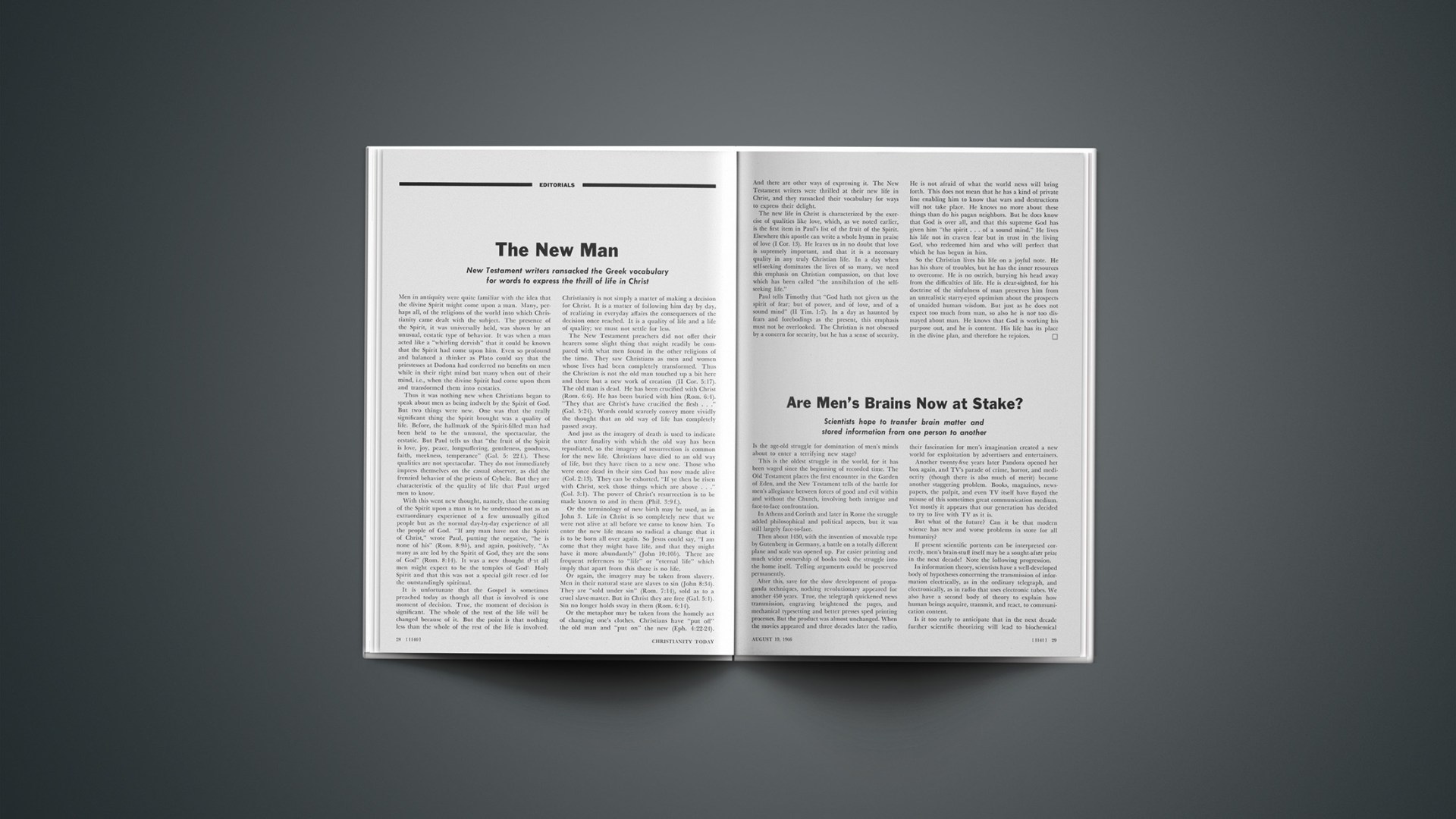Scientists hope to transfer brain matter and stored information from one person to another
Is the age-old struggle for domination of men’s minds about to enter a terrifying new stage?
This is the oldest struggle in the world, for it has been waged since the beginning of recorded time. The Old Testament places the first encounter in the Garden of Eden, and the New Testament tells of the battle for men’s allegiance between forces of good and evil within and without the Church, involving both intrigue and face-to-face confrontation.
In Athens and Corinth and later in Rome the struggle added philosophical and political aspects, but it was still largely face-to-face.
Then about 1450, with the invention of movable type by Gutenberg in Germany, a battle on a totally different plane and scale was opened up. Far easier printing and much wider ownership of books took the struggle into the home itself. Telling arguments could be preserved permanently.
After this, save for the slow development of propaganda techniques, nothing revolutionary appeared for another 450 years. True, the telegraph quickened news transmission, engraving brightened the pages, and mechanical typesetting and better presses sped printing processes. But the product was almost unchanged. When the movies appeared and three decades later the radio, their fascination for men’s imagination created a new world for exploitation by advertisers and entertainers.
Another twenty-five years later Pandora opened her box again, and TV’s parade of crime, horror, and mediocrity (though there is also much of merit) became another staggering problem. Books, magazines, newspapers, the pulpit, and even TV itself have flayed the misuse of this sometimes great communication medium. Yet mostly it appears that our generation has decided to try to live with TV as it is.
But what of the future? Can it be that modern science has new and worse problems in store for all humanity?
If present scientific portents can be interpreted correctly, men’s brain-stuff itself may be a sought-after prize in the next decade! Note the following progression.
In information theory, scientists have a well-developed body of hypotheses concerning the transmission of information electrically, as in the ordinary telegraph, and electronically, as in radio that uses electronic tubes. We also have a second body of theory to explain how human beings acquire, transmit, and react, to communication content.
Is it too early to anticipate that in the next decade further scientific theorizing will lead to biochemical means for transmission of information genetically from generation to generation and directly from person to person through transference of brain matter?
If this sounds fantastic or beyond belief, don’t be too certain. Look at the following recent reports.
Learning acquired in a scientist’s maze has already been transferred from “educated” flatworms to uneducated flatworms when the heads of the former were fed to the latter.
Hydén, the Swedish neurobiologist, not long ago discovered that RNA, the now-well-known ribonucleic acid, is basically changed within certain creatures during the learning process.
At the University of California, in experiments by scientists Fried and Horowitz, a “memory molecule” was transferred from one flatworm to another by the injection of RNA from the first into the second, so that the second knew what the first had formerly known.
One of the pharmaceutical manufacturers has announced the development of a compound that enables rats to learn five times faster. This drug works by speeding up synthesis of RNA. It is reported that the Food and Drug Administration has been asked to authorize its use in human beings.
And scientist Johns, formerly a brain researcher at the University of Rochester, has found that if the human brain is supplied with more RNA, more information can be stored in it. Such successes will speed other experiments to discover the relationship of RNA to human beings.
Also, at UCLA it has been announced that knowledge stored in the RNA in brain tissue can be transmitted from one species to another by hypodermic needles. Scientists Babich, Jacobson, and Bubash are said to have transferred knowledge from hamsters to rats through the medium of RNA.
Already we know that genetic material carries hereditary information that makes each individual be and look like what he is. This is carried in the DNA-RNA complex.
Science’s search for basic knowledge about human beings will not cease—and should not. It is the technological use to which such knowledge is put that gives concern.
For a long time parts of the human body have been transferred from one person to another. The blind have been made to see. The dying have been given new life through blood transfusions. A few other transplants have been successful or partially so. And mechanical devices are keeping still others alive.
We see no moral implications in ethically conducted transplantation of human matter.
But will the day come when biological technology will transplant “educated” human RNA with the hypodermic needle in order to preserve the knowledge of an Albert Einstein or a John von Neumann? What of experiments in which spiritual attitudes are modified, a task heretofore considered the special province of the Holy Spirit?
Possibly the experiment will be tried … perhaps the jab of that needle may already have been started on its historic path before this is published.
Some things we know …
That life, intelligence, and talents come as gifts from the One who created us all;
That on the day of judgment each man will be held accountable for his actions, and further that the omnipotent God knows all we do, say, and think;
That each man is expected to develop fully all the talents with which God has endowed him;
And, finally, that in all brain transplantation efforts, in the use of brain tissue to transmit human experience by whatever method, moral and theological problems are involved that are too grave for further laboratory experimentation until the issues have been made clear.
Man, born a sinful animal and not able to control his lust to exploit, misuse, and destroy his fellow men, is not yet wise enough to use the incredible powers science is gradually putting into his hands.
Should mankind try to alter human genes or chromosomes under any circumstances, would the creatures produced by such alteration be human robots? We may well ask, What of their souls? Man must not assume an impious and infamous role by trying to play God.
The High Cost Of Non-Evangelism
The budget for Billy Graham’s London Crusade ’66 was $840,000. This was, as Graham remarked, “about what Cassius Clay got for less than three minutes in the ring with Sonny Liston.” By any reckoning this is a lot of money, and to the uninformed critic of mass evangelism it seems a big “take” for Graham. The evangelist usually reiterates that none of the money raised locally goes to any member of the team; all is used to defray the expenses of the local crusade for which Graham and his associates have been invited. Still this cash flow for one month’s crusade for souls looks large—particularly to those who have given none of it, or to those who prefer to see church funds expended for non-evangelistic endeavors.
In London approximately 42,500 inquirers came forward for counseling. If only half of these inquirers made genuine decisions for Christ, the evangelistic cost would have been $40 each.
The United Church of Canada (1,063,951 members), largest Protestant denomination in Canada and one of the most vigorous critics of Graham during the past year, has had a steady decline of members “received on profession of faith” since 1958. In 1964, 34,226 members were received; but this was 7,489 fewer than in 1958. The total congregational expenses for the year 1964 were $52,402,219. If only one-fifth was spent on church growth, the cost of adding one new member was over $300, a figure comparable to that in some other larger churches.
If the main objective of every church and evangelistic crusade is church growth, can such an expenditure be accepted with indifference? Canadian ecclesiastics who deplore the high cost of mass evangelism ought rather to deplore the higher cost of non-evangelism.
Some ardent ecumenists also would do well to reckon with the plain facts when they hail church union as a way of accelerating the missionary program at reduced cost. The first large church union in North America came about in 1925, when Methodists, Presbyterians, and Congregationalists formed the United Church of Canada. At that time the Methodists and Presbyterians had a total of 550 missionaries in the field. Today, after forty years of combined effort, there are only 263 missionaries, even though the membership of the church has nearly doubled.
During this same period, the total number of missionaries sent by North American churches has increased. This increase comes chiefly from the small evangelical churches rather than from the larger union churches. Whatever might be the advantages of church union, expansion of the missionary program, which ought to have priority, does not appear to be one of them.









